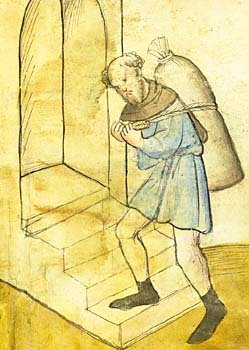
An inmate of a retirement home, identified only as Conrad,
is depicted in his earlier occupation ( ca.1400) of porter, carrying into a private house
a sack tied to his back.
From the Hausbuch der Mendelschen Zwölfbrüderstiftung
Transportation of commercial goods by land could take a number of forms. The most basic was of course human labour, with individual porters carrying goods upon their back or dragged on a sled, or porters working in tandem to carry goods on a hand-barrow. Wheelbarrows became increasingly common during the Late Middle Ages. Both types of barrow are often seen in medieval artwork, such as the examples here and here, which clearly connect portered wheelbarrows with commercial goods. Sleds could also be dragged by horses, as mentioned at Lynn and shown in Simon Bening's painting of the Bruges wine market.
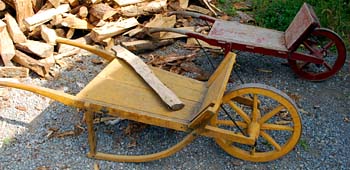
(above) Wheelbarrows represent a simple technology that has
altered little since the Middle Ages, as these mid-nineteenth century examples (replicas
used at Upper Canada Village) show.
(below) More useful for longer-distance transport of goods – such as by peasants
bringing produce to the nearest town's market – were handcarts like this (part
of the Canadian Museum of Civilization exhibit of a New France market scene).
Photos © S. Alsford
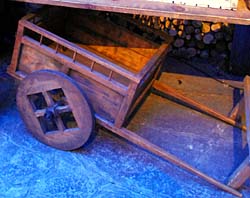
Handcarts are rarely seen in medieval art. More commonly depicted – such as in the Luttrell Psalter – are the larger two-wheeled carts that were typically drawn by a single horse between two shafts, but capable of harnessing more draught animals if necessary. Using such depictions, the Weald and Downland Open Air Museum reconstructed a cart. Its sides (which increased loading capacity) are made of vertical rods, blocked in by lattices, while at rear a hinged gate doubles as ladder. The front end is open. One shaft is attached to the cart, a second (with driver's seat attached) lies underneath it. Above it hangs a yoke. The wheels are iron-shod, which could have caused a problem for towns attempting to keep in good repair paving on their main streets. Yet such carts were essential to the operation of medieval society, and were used by civic authorities for their own purposes, such as transporting materials for building projects or removing garbage or offal from the town. They must have been a fairly common sight on roads and streets, and we hear of traffic accidents and incidents of road rage.
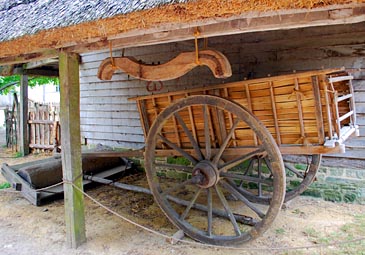
(above) The two-wheeled cart at the Weald and Downland
Open Air Museum.
(below)Representation of a two-wheeled cart (here being used to load hay) on
a wall-tile of ca.1330; British Museum.
Photos © S. Alsford
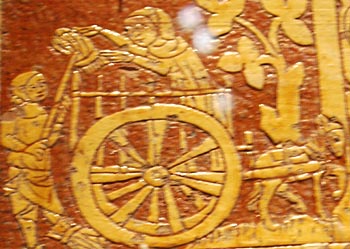
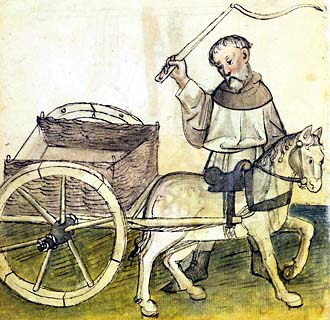
From the Hausbuch der Mendelschen Zwölfbrüderstiftung
(above) A carter identified only as Leopold is depicted,
ca.1400, standing next to his cart, which he evidently drives from the saddle of
the horse.
(below) The two-wheeled cart remained a staple of farm life into the mid-nineteenth
century, here transporting firewood; Upper Canada Village.
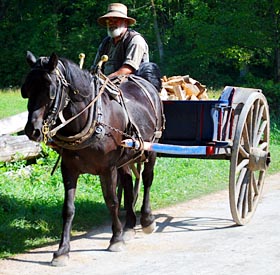
Photo © S. Alsford
Four-wheeled wagons are less frequently evidenced in medieval illustrations, yet must have been used for large, heavy loads. Up to about the mid-twelfth century oxen were preferred to horses for heavy hauling, but thereafter the use of horses grew rapidly in popularity, for a variety of reasons [for which , see John Langdon,"Horse hauling: A revolution in vehicle transport in twelfth- and thirteenth-century England," in Landlords, Peasants and Politics in Medieval England, ed. T.H. Aston, Cambridge University Press, 1987, 36]. Larger vehicles and the acquisition and maintenance of teams to pull them, represented an investment not all could afford; but since horses moved faster than oxen, it may well have been an investment that many felt would pay off, given the growth of the market network, which favoured quicker distribution of lighter loads.
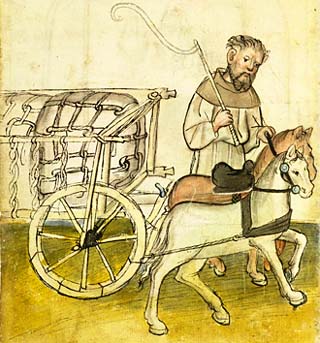
From the Hausbuch der Mendelschen Zwölfbrüderstiftung
(above) In his portrait of Kunz Wagenmann, an early fifteenth century
waggoner transporting large bales of merchandize, the artist has not bothered to include
the rear wheels of what must be a four-wheeled wagon.
(below) A gold table decoration in form of a wagon and tun, made (Germany) 1554
and given to the London Mercers' Company some years later; the clockwork wagon ran
along the table while from the tun rosewater sprinkled over diners' hands. This is
another instance of the infiltration of objects associated with commerce into high culture.
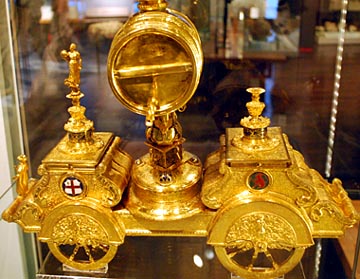
Photo © S. Alsford
Wagons made possible the inland transportation of larger quantities of commercial goods. But we must remember that human labour remained necessary, not just in driving the wagon, but also in loading and unloading it.
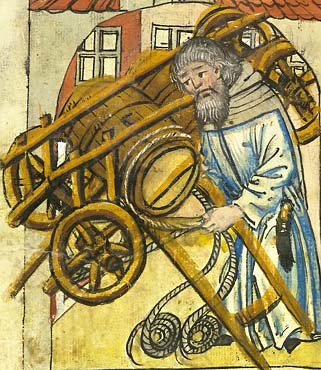
(above) Ulrich Windysch (d. 1281) was a wine porter who worked out
of the wine market at Nuremberg; here he is shown using a rope and a ramp to remove
wine barrels from a cart.
(below) Leonard Schuster worked as a bale-binder until retiring in 1530.
The commemorative portrait made upon his death four years later shows him at work
inside a warehouse (the windows are barred), using a lever to tighten the ropes
around a bale; across his shoulder is wrapped a supply of rope.
From the Hausbuch der Mendelschen Zwölfbrüderstiftung
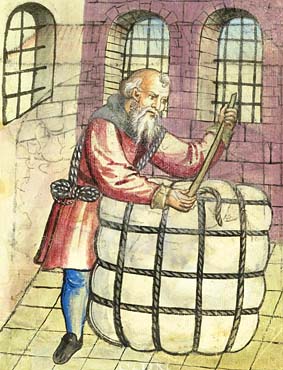
Finally, packhorses were used a great deal to carry sacks or baskets filled with goods, slung on either side of the horse (or ass). The adoption of summa (pack-saddle) as a measure of grain and salt reflects the use of horses to carry such packs. Although Domesday shows oxen employed to pull vehicles, it also records the use of packhorses and even includes a prohibition against overloading such horses (for purpose of reducing the amount of toll payable). Packhorses, even if overloaded, could carry less than a cart, but were able to traverse roads in poorer condition and deviate from established roads to which wagons needed to stick.
Local traditions often mention packhorse routes, and many bridges were built specifically to cater to packhorses; they were very narrow and had low or no parapets, perhaps to avoid interfering with the packs hanging down from the sides of horses – although parapets were not a common feature of medieval bridges in general. Because horse-pulled vehicles could transport bigger loads, the use of packhorses in long-distance trade seems to have declined in the Late Middle Ages; but they were probably still much used in carrying goods within towns and suburbs, such as from port to purchaser's warehouse or residence.
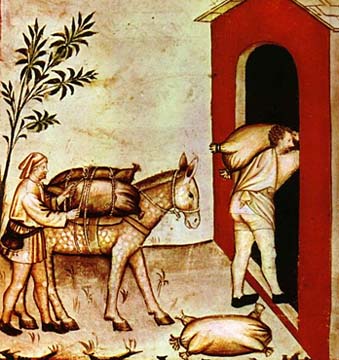
Porters using a packhorse to transport oil, in pig-skins containers,
to a warehouse.
From the Tacuinum Sanitatis